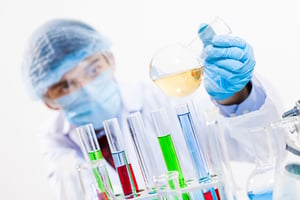Explosive chemicals. High-pressure gasses. Flammable liquids. Toxic substances. Dangerous projectiles.
Why is lab safety important? Because each of the potential risks outlined above can lead to laboratory mishaps, or worse, catastrophic consequences.
It’s unclear exactly how many accidents occur in laboratories each year. An Occupational Safety and Health Research Institute study found that among 220 participants, 45% had experienced accidents in the lab. About 74% reported exposure to chemicals, while about 45% of respondents reported inhalation specifically.
A survey published in the journal, Nature, also found that 25 to 38% of academic lab personnel who had been involved in an accident or injury in the lab never reported it to a supervisor or investigator.
Let’s face it. Laboratory work can be dangerous. Yet it can be incredibly rewarding as well, and with the right guidelines put into place, the work performed in labs can be safe. Let’s explore some of the greatest hazards found in the lab, and what you can do to ensure your employees remain safe.
Electrical Components
Electrical cords, outlets and equipment like oscilloscopes, power supplies and soldering irons are often found in laboratories. Misuse or simply poor layouts of these items can result in tripping hazards, accidental shocks or fires.
Tips to improve lab safety:
-
Never leave power cords near heat sources
-
Do not run extension cords across or near doorways
-
Do not connect power strips together
-
Label high voltage equipment with signs warning of danger
-
Before inspecting power equipment, turn power and circuit breakers off
-
Only use equipment with non-conducting handles when working with electrical devices
-
When examining an operating circuit, avoid making your body a closed circuit by keeping one hand in your pocket or behind your back
-
Keep work areas near electrical devices and outlets clear of paper, books and other clutter
-
Avoid using electrical equipment around any water sources unless the equipment is designed for that use
-
Do not use flammable substances near electrical equipment
-
Keep electrical panels unobstructed
-
Avoid creating sparks where static electricity is a concern
One of the ways you can help minimize electrostatic discharges in a lab is by choosing lab clothing and furniture that helps protect against ESD. Spark sources can be a major concern in laboratories. If ESD, or electrostatic discharge, is a concern in your lab, you will want to ensure your technicians wear PPE or clothing that is made of static dissipative fabric.
Fume Hoods
A laboratory fume hood removes substances that may cause harm, such as fumes, aerosol, gasses, vapors and dust. They also create a barrier between the lab when a chemical reaction occurs.
While this important piece of lab equipment is rooted in safety, it’s important to follow a separate set of guidelines to ensure the fume hood is operating efficiently and safely.
In 2008, a UCLA research assistant died after a reagent she was using ignited spontaneously in the air. As she was transferring a tert-butyllithium (t-BuLi) solution using a plastic syringe, the plunger came out of the syringe barrel and the reagent was exposed to the air. The t-BuLi solution and the research assistant’s clothing ignited.
To help avoid a scenario like the one above, your fume hood safety checklist should include these tips to improve lab safety:
-
Know the chemicals that are being worked with and any potential reactions of those chemicals
-
Ensure the hood sash is opened to the proper height to provide the proper level of protection.
-
Check the air gauge to ensure the airflow is within the required range.
-
Make sure the exhaust fan is working so that hazardous chemical fumes can escape.
-
Check the baffles in the exhaust fan since these keep airflow uniform.
-
Double check there are no spark sources nearby that can cause a fire or explosion.
-
Examine the air filters to ensure they are not clogged.
-
Ensure anyone operating under a fume hood is wearing the proper PPE, or personal protective equipment (Clean room garments like lab coats, coveralls and full body suits; eye protection like goggles and face shields; gloves and more)
All new employees should also be up-to-date on proper use of fume hood equipment. Current workers should regularly undergo refresher training as well, especially if a new chemical is being used under the hood.
Glassware
When handling any type of laboratory glassware, such as beakers, funnels and burettes, there are several steps lab technicians can take to protect themselves.
Tips to improve lab safety:
-
Inspect all glassware before use for chips or cracks
-
Move slowly and steadily when transferring chemicals from one glassware to another
-
Keep glassware from edges when working
-
Stir gently during the heating of a solution in a glass container
-
Avoid heating liquids on a direct flame
-
Wear the proper protection, including lab coats, chemically-resistant gloves and protective eyewear
When choosing the proper eyewear, you typically have three choices: Lab safety glasses, goggles and face shields.
Lab safety glasses, goggles and face shields all provide different levels of protection. Lab safety glasses often have shatter-resistant lenses and are designed to stop large objects from injuring eyes. Lab safety goggles may be a better fit if your lab workers regularly deal with chemicals, bloodborne pathogens or other substances that produce mists, vapors or fumes.
Face shields are not designed to be the only appropriate eye protection a lab worker should wear. Instead, they can help provide additional protection when worn over eye protection glasses or goggles. Face shields also help protect the entire face, rather than only eyes.
Chemicals
Hazardous chemicals pose significant risks for lab workers. The Occupational Safety and Health Administration (OSHA) currently has rules that limit exposures to nearly 400 substances. These include a wide variety of carcinogens, corrosives, neurotoxins and other agents that damage the human body.
currently has rules that limit exposures to nearly 400 substances. These include a wide variety of carcinogens, corrosives, neurotoxins and other agents that damage the human body.
Every employee should be trained according to the types of chemicals and substances used in your lab. In fact, OSHA requires that laboratories identify possible hazards and develop a Chemical Hygiene Plan (CHP). This plan is a written program that states specific policies, procedures and responsibilities that labs have in protecting workers from health hazards associated with any chemical used in a workplace.
In addition to creating a Chemical Hygiene Plan, lab managers can take other actions to protect employees from chemical hazards.
Tips to improve lab safety:
-
Ensure any fabric a technician is wearing is resistant to chemicals (such as polypropylene, which allows moisture to evaporate more quickly and is resistant to many acids and alkalis)
-
Never leave containers of chemicals open and unattended
-
Do not consume beverages and food where hazardous chemicals are used or stored
-
Never pour chemicals down drains, and instead according to chemical waste disposal regulations
-
Do not store chemicals inside a fume hood, but rather in the proper laboratory cabinets
While selecting the right laboratory cabinets for your workspace can be challenging, one of the best and most commonly used materials today is steel. Variations of steel, such as stainless steel, are some of the most common materials used to construct lab cabinetry because steel components are heavy duty and provide maximum strength and rigidity. Steel is also an effective material choice for labs that require a sterile or hygienic environment.
Make sure the laboratory cabinets you consider can safely store the chemicals you use. Locks can also add an additional layer of protection if substances should be secured.
Physical Hazards
Finally, one of the most common yet overlooked hazards present in labs today are physical injuries sustained.
The Bureau of Labor Statistics reports that sprains, strains and tears collectively are the leading type of injury in manufacturing. While at first glance these seem like minor injuries, they can still impact time on the job, worker efficiency and overall productivity.
Ergonomically-designed pieces of furniture, from the industrial workstation itself to the lab chairs employees sit in, focus on keeping the body in its natural position. Alternatively, when employees must continuously bend, twist and turn, they are more prone to painful injuries.
Tips to improve lab safety:
-
Consider benches that easily raise and lower, such as ergonomically adjustable hydraulic benches
-
Don’t forget industrial chairs that feature sturdy frames, adjustable heights and comfortable backrests and seats
-
Don’t overlook other workbench features that can impact the physical health of a worker, such as the placement of drawers and utility features so that employees do not have to extend in an unnatural position to reach them
Lab managers often worry about hazardous conditions that can quickly develop, but sometimes the most costly injuries can happen over time. A lab that is designed ergonomically-friendly can help ensure a healthy, productive employee in the long run.



